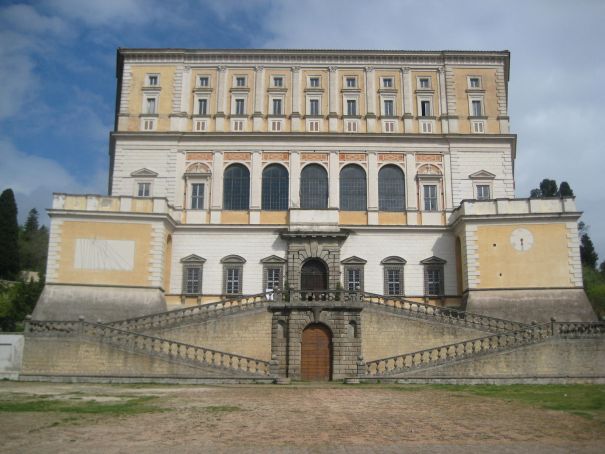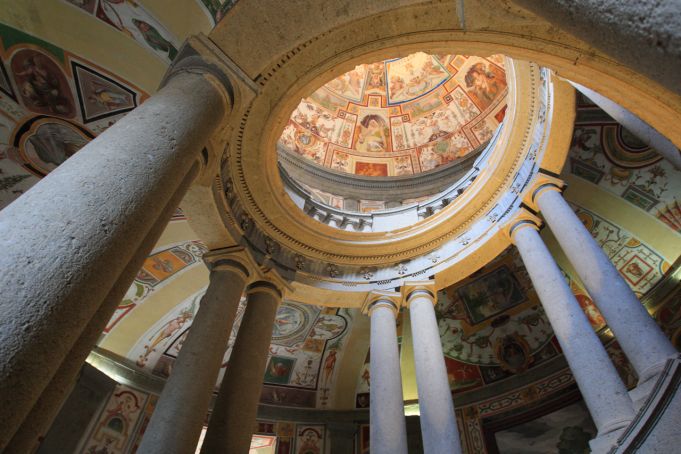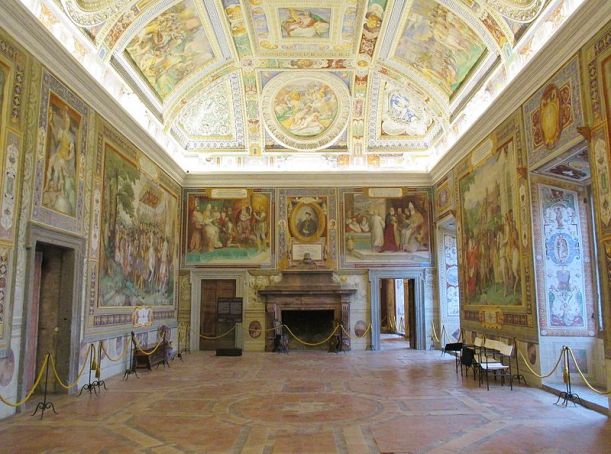The Farnese palace above Lago di Vico in north Lazio is a monument to the Farnese family and to the Mannerist style.
The Monti Cimini with their volcanic lakes of Lago di Vico and Lago di Bolsena lie about 50km along the ancient Roman consular road, the Via Cassia, which runs north from Rome towards Florence.Above Lago di Vico perches Caprarola, on land once occupied by goats, hence its name. Today the goats have vanished, to be replaced by a stupendous palace, Palazzo Farnese (also known as Villa Farnese), on five floors, an outstanding example of Mannerist architecture and decoration, elongating its vertical lines for greater effect and dominating the small town of Caprarola. Cardinal Alessandro Farnese started building Palazzo Farnese in 1556 on the foundations of an earlier pentagonal fortress planned by his grandfather, an earlier Cardinal Alessandro Farnese, who then became Pope Paul III.
Farnese family
The Farnese family originated in Tuscany, claiming family connections with the Hapsburgs and the Portuguese royal family. In gratitude for their military intervention in restoring papal property by Pope Urban V in 1368 at Viterbo and Montefiascone, they were granted confirmation of their possessions in northern Lazio and raised to the social status of such famous Roman families as the Orsini, Savelli and Sforza.
Also read: Villa Lante in Bagnaia
Future generations expanded their land in the 1400s, slowly moving closer to Rome, the seat of power and wealth in the Middle Ages, establishing themselves on the shores of Lake Bolsena and increasing their influence by marrying into the baronial Caetani family of Pope Boniface VIII.

Also read: Best Piazzas in Rome
The sack of Rome in 1527 had seen artists leave the city, and it lost its position as a cultural centre, but under Paul III a new wave of projects saw this new Mannerist style emerge. It was a departure from the classical architectural orders and saw unconventional aspects emerge in artwork such as the posture, positioning, features and facial expression and proportion of those depicted, as well as unusual colour combinations. Palazzo Farnese is a prime example of this style.
- Also read: The Via Francigena, an ancient pilgrim route
- Also read: The Wines of Lazio
Borgia Pope
Paul III had also been helped to become a cardinal by his sister, the beautiful Giulia Farnese. She married Orsino Orsini in Rome in 1489, but within four years she was living near the Vatican as the mistress of Rodrigo Borgia, by then Pope Alessandro VI. Giulia used her influence to get her elder brother Alessandro Farnese made a cardinal in 1493.Also read: Metamorphoses in the Turano Valley
Palazzo Farnese stands today as a reminder of Paul III's unprecedented nepotism, of Alessandro Farnese's patronage of the arts and also as a tribute to the architectural and artistic influences of Mannerism, the style that dominated for some 60 years (1520-80), examples of which can also be seen in the castle at Rocca Sinibalda and in palaces in Mantova and at Palazzo Massimo in Rome.
The palace itself is considered an outstanding example of the work of Jacopo Barozzi da Vignola, the leading Mannerist architect who created an innovative circular courtyard within the pentagonal base.

The rooms reveal an extraordinary cycle of wall paintings of the period 1560-83 celebrating themes from history, mythology, the seasons and the Bible in celebration of the Farnese family. Vignola painted architectural designs in many rooms to create the illusion of larger spaces.
Also read: How to visit Palazzo Farnese
The first floor is called the prelates' floor, which those arriving on foot could also access from an external staircase. It contains the guardroom and a room celebrating the liberation of Malta and the Christian fleet leaving Messina, plus a set of rooms dedicated to each of the four seasons.
Also read: Visiting Villa Farnesina
The royal staircase, with its wide handrail on which weighted bags could be slid, continues upwards to the rooms of the piano nobile, to the summer apartments which are entered through a loggia dedicated to Hercules, who according to mythology formed Lago di Vico in a trial of strength, a theme dear to Cardinal Farnese's heart.
Heroic past
Originally an unglazed open portico opposite contained a statue of the Greek hero as part of a stucco and mosaic feature with a fountain arrangement to cool the dry summer air. The portico leads to the chapel with its frescoes of Old Testament themes and then to a room dedicated to the Farnese family's heroic past.The council anteroom is decorated with frescoes exalting Paul III's achievements in setting up the Council of Trent, his fight against Turkish expansion and his excommunication of Henry VIII in 1538.
Also read: Rome's best museums
The public audience rooms lead to Cardinal Farnese's private quarters – his bed chamber, his dressing room and his study – all with appropriate frescoed themes such as Minerva introducing early man to the idea of wearing clothes and the making of woollen garments which feature in the cardinal's dressing room. The frescoes in his bedroom show the moon and Mercury bringing in night, while Aurora brings in dawn from the window to chase night away.

On the floor above, a large airy room contains frescoes of maps of the world as it was known in 1573, and of Italy and the Holy Land. Other rooms such as the cardinal's winter bedroom feature Biblical dreams and angels delivering messages from God.
Pleasure Casino
From this floor it is possible to cross the deep moat and enter the lower gardens, now formal parterres but full of colourful plants in the past.A beautiful grotto with a pond is carved out of the rocks at one end of the garden, while low steps lead into the chestnut wood above and on up to the Pleasure Casino built dominating a water cascade overlooked by reclining stone gods and guarded by large statues of myths.
Also read: Traveling Lazio by Bus
Since 2015 Palazzo Farnese has been part of the Lazio region's museum department in the ministry of culture, which has invested some €6 million in maintenance and restoration. The ArtCity 2018 festival, organised by the ministry of culture, opened the castle to musical and theatrical events during the summer. In 2017 visitor numbers increased to 71,000 from 57,000 the previous year, with further gains expected this year.
By Philip Biss
Palazzo Farnese is open Tues-Sun 08.30-19.30. The gardens are open Tues-Sat 08.30 to an hour before sunset in good weather. The villa and the gardens are closed Christmas Day, 1 Jan and 1 May. Opening times may vary, so check the culture ministry website. For more information on admission charges, opening times and directions visit the Villa Farnese website.
This article was published in the November 2018 edition of Wanted in Rome magazine.
General Info
View on Map
Villa Farnese at Caprarola: enchanting day trip from Rome
Piazza Farnese, 1, 01032 Caprarola VT, Italia

















